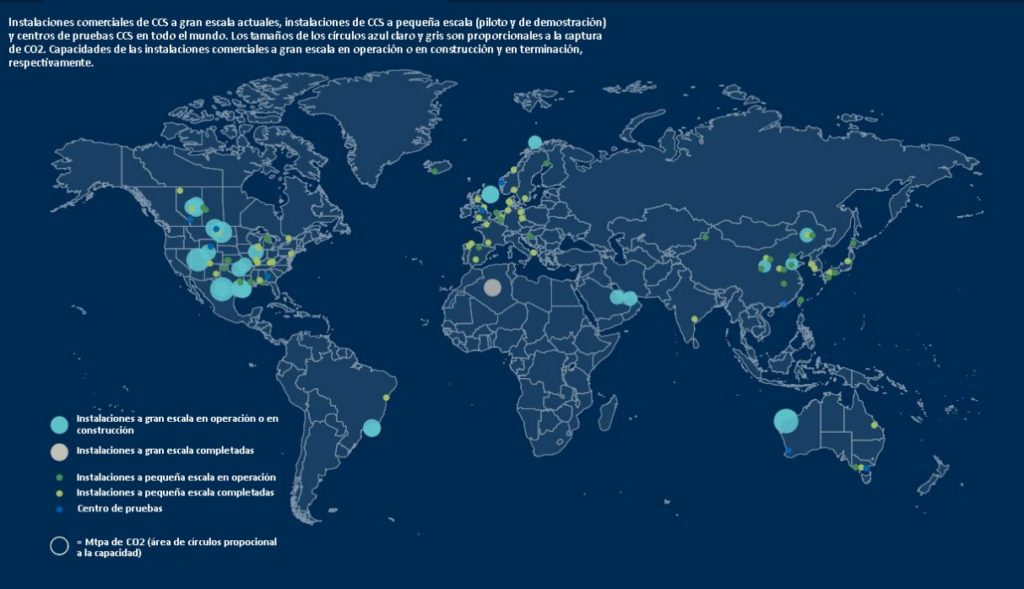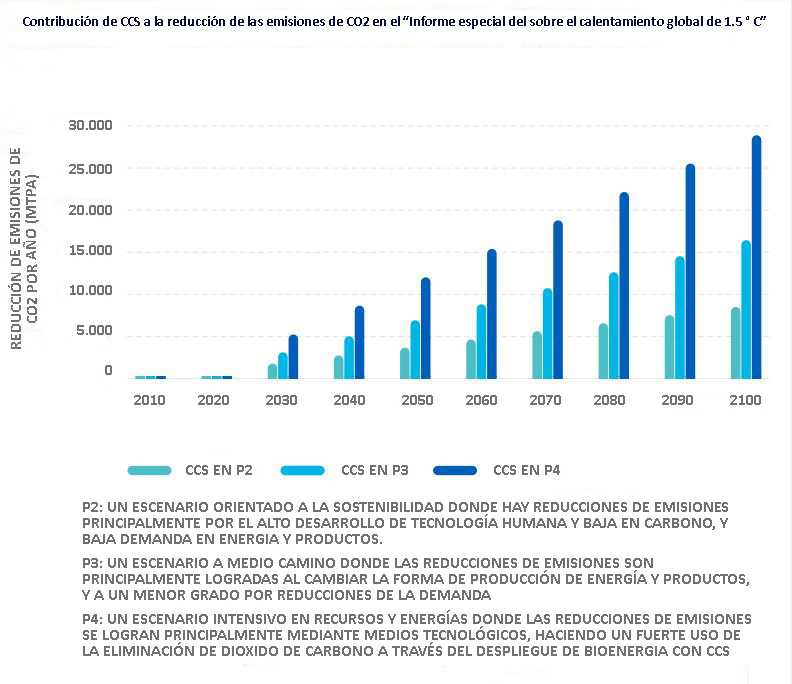admin | 28/08/2019
Capturing, storing and reusing carbon dioxide is vital to overcoming climate change. Today it is no longer enough to reduce emissions into the atmosphere (nearly 40 billion tons a year), rather the excess of harmful particles must be eliminated. This situation has led organizations and companies to develop over the last few decades the most advanced technologies for trapping those greenhouse gases and reducing global warming.
Luis Díaz, chairman of the Spanish CO2 Technology Platform (PTECO2), notes that the Paris Accord, signed by 197 countries in 2016, was the first global compact to fight climate change. This agreement involved accepting a series of commitments by the nations to make it possible for the temperature increase on our plant to not exceed 2° C, which is considered by experts to be the limit to avoid changing the nature of our environment. The signatories also agreed to work toward achieving a margin of less than 1.5° C.
Two years earlier, the European Council had already expressed its commitment in this area with the approval of the ‘2030 Climate and Energy Framework,’ which established minimum objectives of reducing greenhouse gas emissions by 40% compared to 1990 levels, the use of a quota of 27% renewable energies, and a 27% improvement in energy efficiency.
Looking a little further, to 2050, the European Commission wants to achieve a “climate-neutral Europe” by investing in realistic technological solutions, educating citizens and standardizing actions in key areas, such as industrial policy, financing, and research, guaranteeing at the same time social justice for a fair transition. “Without techniques that facilitate more innovative, effective, and sustainable processes, citizens cannot maintain their current lifestyle as we know it for long, and Europe will not achieve its maximum objective, which is to continue to enjoy a sustainable environment that does not suffer alterations due to climate change,” says Luis Díaz.
To achieve that, technologies with low or zero carbon dioxide (CO2) emissions are already being applied, such as CCS (Carbon Capture and Storage), which makes it possible to capture, transport, store, use, and transform CO2. These advances make it possible to prevent an average of 90% of the gases produced in major emission sources from reaching the atmosphere and may represent between 10-15% of the total reduction necessary for emissions on a global level. “CCS technologies, together with energy efficiency and renewable technologies, will make up an adequate energy mix to continue the fight against climate change,” says the PTECO2 chairman.
CO2 Applications
Once the carbon dioxide has been captured at the source — primarily power plants and industrial plants — it is compressed and transported to an appropriate storage location, such as geological formations, or it can be used directly or once the gas has been transformed:
– Direct use. Use of CO2 in the agri-food industry (to obtain decaffeinated coffee and the necessary pressure in beer, carbonated beverages, and preservative atmospheres, among other possibilities), for water treatment, etc.
– Transformation. When the CO2 is transformed it is possible to obtain products with high added value, such as urea in the case of conventional chemical conversion processes. Among the innovative processes based on the use of energy, there are different options that have been studied in depth and applied in recent years, such as the hydrogenation of CO2 to obtain fuels and chemical products with one carbon atom, such as methanol, methane, and formic acid.
To carry out this process, there are currently 19 large-scale pilot plants around the world that are operational, four in advanced development (in Australia, the Netherlands, Norway, and the US), five under construction (in China, Canada, and Australia) and 16 projects under development. In Spain, in addition to the now-defunct Elcogas, there are three operational CO2 capture pilot plants (Ciuden, La Pereda, and La Robla).
In addition, according to Díaz, following the global economic crisis, investments are beginning to grow globally in this type of technology. To a certain extent, the increased cost of CO2 (that is, what it costs to emit one ton of the gas into the atmosphere) is leading to an increase in investments in low-carbon technologies. Internationally, there are several organizations that facilitate cooperation among countries, such as the International Energy Agency, the Global CCS Institute, and the Zero Emissions Platform, which works as a European technology platform.
Large-scale commercial CCS facilities

Fuente: Base de datos de Global CCS Institute
Safety Guarantees
From the point of view of safety, all processes for the capture, transportation, storage, use, and transformation of carbon dioxide with CCS technologies include a series of protective measures to guarantee the entire process, as explained by the head of PTECO2:
– Capture. This has been under development in the US since the 1970s, so there are standardized protocols that guarantee the reliability of the process, without involving “any risk greater than that of other common technologies.”
– Transportation. It is transported by CO2 pipelines, which are very similar to those used for natural gas. In the design phase, selection of the layout and hydro-mechanical field is essential. In the construction phase, safety is a priority on the worksite, which is very similar to any pipeline transportation infrastructure and is outlined in the Occupational Risk Prevention Act. In the operations and maintenance phase, care must focus on formulating all operations, maintenance, and emergency procedures within a system of joint management.
– Storage. The gas is accumulated in underground formations at least 800 meters from the surface and safety is related primarily to the seal, which is the natural layer that guarantees that the injected CO2 is kept in the storage formation and does not move to upper layers. The seal layer must “have a mineral makeup, continuity, power, useful thickness, and mechanical resistance to act as a rock that is impermeable to CO2.” To determine the characteristics perfectly, techniques are used such as monitoring and characterization.
– Transformation and use. Handling this gas shouldn’t cause any safety problems or health risks with appropriate working conditions, as it is not a toxic or explosive substance and because of the minimal volume that is handled. In particular, one of the properties of this gas is precisely its fire-extinguishing capabilities.
CCS’ contribution to reducing CO2 emissions

Source: Global CCS Institute database and the ‘Special Report on 1.5° C Global Warming’ from the Intergovernmental Panel on Climate Change (IPCC)
Future Outlook
Although the benefits of applying technology to stop climate change are obvious, its implementation must still overcome some barriers. Like all technologies in the development stage, its application is initially expensive, so it requires significant investments. To solve this problem, there are several organizations, such as the European Commission, that offer aid in this area, but private capital is also required, given the number of projects underway which also require cooperation among several countries.
At the regulatory level, many countries lack a more developed regulatory framework beyond the mere transposition of EU directives, as in Spain, where regulations such as Directive 2009/31/EC on geological storage have simply been implemented through Law 40/2010 of 29 December. “There was no subsequent regulatory development that could specify all necessary aspects,” regrets Luis Díaz, who says that it is “a vicious circle: without projects there is no regulation; without regulation no projects can get underway with all the regulatory security required.”
Still, there are many countries that are already supporting the development and deployment of these technologies, such as the United States, which introduced a significant stimulus in 2018 for investment in CSS technologies with the approval of laws to expand and improve the tax credit. It provides up to per ton of CO2 stored permanently and per ton of CO2 used for improved recovery of oil or other industrial uses, as long as the emission reductions can be clearly proven. The International Energy Agency calculates that this could trigger new capital investments of some ]
billion in the next six years, which could add from 10 to 30 million tons or more of additional CO2 capture capacity.
The primary challenge with all of this is related to capture technologies, “both with regard to the most adequate application of each technology in the emitting industry (cement, steel, chemicals, etc.), as well as the use of current technologies to eliminate diffuse emissions,” specifies Díaz.
He also highlights the challenges in confronting CO2 usage, which must reach a level of development that enables a quantitative step forward with regards to re-usage quantities. And further work is also needed on geological storage to establish the definitive definition of storage locations and quantities, both locally and globally.
This article was written with the participation of…

Luis Díaz Fernández is a Mining Engineer from the University of Oviedo. He has over 25 years of experience in the energy production sector, first as an engineer responsible for commissioning thermal power plants and their results at Foster Wheeler Energía S.A. and then as the Energy Division Manager at Servicios y Proyectos Avanzados S.A.
He is currently the Manager of the La Pereda Thermal Power Plant, owned by Hunosa, where he is also responsible for the CO2 capture project using carbonation/calcination, developed jointly with Endesa and INCAR-CSIC. He has been the chairman of the Spanish CO2 Technology Platform (PTECO2) since March 2015.





